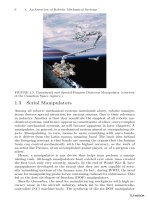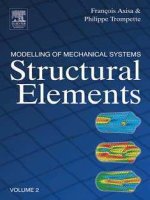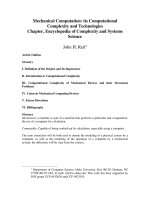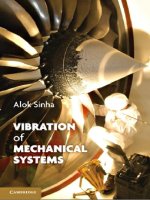Fundamentals of robotic mechanical systems robots robotics ( TQL )
Bạn đang xem bản rút gọn của tài liệu. Xem và tải ngay bản đầy đủ của tài liệu tại đây (10.05 MB, 545 trang )
Fundamentals of Robotic
Mechanical Systems:
Theory, Methods, and
Algorithms,
Second Edition
Jorge Angeles
Springer
TLFeBOOK
Mechanical Engineering Series
Frederick F. Ling
Series Editor
Springer
New York
Berlin
Heidelberg
Hong Kong
London
Milan
Paris
Tokyo
TLFeBOOK
Mechanical Engineering Series
J. Angeles, Fundamentals of Robotic Mechanical Systems:
Theory, Methods, and Algorithms, 2nd ed.
P. Basu, C. Kefa, and L. Jestin, Boilers and Burners: Design and Theory
J.M. Berthelot, Composite Materials:
Mechanical Behavior and Structural Analysis
I.J. Busch-Vishniac, Electromechanical Sensors and Actuators
J. Chakrabarty, Applied Plasticity
G. Chryssolouris, Laser Machining: Theory and Practice
V.N. Constantinescu, Laminar Viscous Flow
G.A. Costello, Theory of Wire Rope, 2nd ed.
K. Czolczynski, Rotordynamics of Gas-Lubricated Journal Bearing Systems
M.S. Darlow, Balancing of High-Speed Machinery
J.F. Doyle, Nonlinear Analysis of Thin-Walled Structures: Statics,
Dynamics, and Stability
J.F. Doyle, Wave Propagation in Structures:
Spectral Analysis Using Fast Discrete Fourier Transforms, 2nd ed.
P.A. Engel, Structural Analysis of Printed Circuit Board Systems
A.C. Fischer-Cripps, Introduction to Contact Mechanics
A.C. Fischer-Cripps, Nanoindentation
J. García de Jalón and E. Bayo, Kinematic and Dynamic Simulation of
Multibody Systems: The Real-Time Challenge
W.K. Gawronski, Dynamics and Control of Structures: A Modal Approach
K.C. Gupta, Mechanics and Control of Robots
J. Ida and J.P.A. Bastos, Electromagnetics and Calculations of Fields
M. Kaviany, Principles of Convective Heat Transfer, 2nd ed.
M. Kaviany, Principles of Heat Transfer in Porous Media, 2nd ed.
E.N. Kuznetsov, Underconstrained Structural Systems
(continued after index)
TLFeBOOK
Mechanical Engineering Series (continued from page ii)
P. Ladevèze, Nonlinear Computational Structural Mechanics:
New Approaches and Non-Incremental Methods of Calculation
A. Lawrence, Modern Inertial Technology: Navigation, Guidance, and
Control, 2nd ed.
R.A. Layton, Principles of Analytical System Dynamics
F.F. Ling, W.M. Lai, D.A. Lucca, Fundamentals of Surface Mechanics With
Applications, 2nd ed.
C.V. Madhusudana, Thermal Contact Conductance
D.P. Miannay, Fracture Mechanics
D.P. Miannay, Time-Dependent Fracture Mechanics
D.K. Miu, Mechatronics: Electromechanics and Contromechanics
D. Post, B. Han, and P. Ifju, High Sensitivity Moiré:
Experimental Analysis for Mechanics and Materials
F.P. Rimrott, Introductory Attitude Dynamics
S.S. Sadhal, P.S. Ayyaswamy, and J.N. Chung, Transport Phenomena
with Drops and Bubbles
A.A. Shabana, Theory of Vibration: An Introduction, 2nd ed.
A.A. Shabana, Theory of Vibration: Discrete and Continuous Systems,
2nd ed.
TLFeBOOK
Jorge Angeles
Fundamentals of Robotic
Mechanical Systems
Theory, Methods, and Algorithms
Second Edition
123
TLFeBOOK
Jorge Angeles
Department of Mechanical Engineering
and Centre for Intelligent Machines
McGill University
817 Sherbrooke Street
Montreal, Quebec H3A 2K6, Canada
Series Editor
Frederick F. Ling
Ernest F. Gloyna Regents Chair in Engineering
Department of Mechanical Engineering
The University of Texas at Austin
Austin, TX 78712-1063, USA
and
William Howard Hart Professor Emeritus
Department of Mechanical Engineering,
Aeronautical Engineering and Mechanics
Rensselaer Polytechnic Institute
Troy, NY 12180-3590, USA
Library of Congress Cataloging-in-Publication Data
Angeles, Jorge, 1943–
Fundamentals of robotic mechanical systems : theory, methods, and algorithms / Jorge
Angeles.—2nd ed.
p. cm.—(Mechanical engineering series)
Includes bibliographical references and index.
ISBN 0-387-95368-X (alk. paper)
1. Robotics. I. Title. II. Mechanical engineering series (Berlin, Germany)
TJ211 .A545 2002
629.8'92—dc21
2001054911
ISBN 0-387-95368-X
Printed on acid-free paper.
© 2003 Springer-Verlag New York, Inc.
All rights reserved. This work may not be translated or copied in whole or in part without the written
permission of the publisher (Springer-Verlag New York, Inc., 175 Fifth Avenue, New York, NY
10010, USA), except for brief excerpts in connection with reviews or scholarly analysis. Use in connection with any form of information storage and retrieval, electronic adaptation, computer software,
or by similar or dissimilar methodology now known or hereafter developed is forbidden.
The use in this publication of trade names, trademarks, service marks, and similar terms, even if they
are not identified as such, is not to be taken as an expression of opinion as to whether or not they are
subject to proprietary rights.
Printed in the United States of America.
9 8 7 6 5 4 3 2 1
SPIN 10853235
Typesetting: Pages created by the author using a Springer TeX macro package.
www.springer-ny.com
Springer-Verlag New York Berlin Heidelberg
A member of BertelsmannSpringer Science+Business Media GmbH
TLFeBOOK
To Anne-Marie, who has given me
not only her love, but also her precious time,
without which this book would not have been possible.
TLFeBOOK
Mechanical Engineering Series
Frederick F. Ling
Series Editor
Advisory Board
Applied Mechanics
F.A. Leckie
University of California,
Santa Barbara
Biomechanics
V.C. Mow
Columbia University
Computational Mechanics
H.T. Yang
University of California,
Santa Barbara
Dynamical Systems and Control
K.M. Marshek
University of Texas, Austin
Energetics
J.R. Welty
University of Oregon, Eugene
Mechanics of Materials
I. Finnie
University of California, Berkeley
Processing
K.K. Wang
Cornell University
Production Systems
G.-A. Klutke
Texas A&M University
Thermal Science
A.E. Bergles
Rensselaer Polyechnic Institute
Tribology
W.O. Winer
Georgia Institute of Technology
TLFeBOOK
Series Preface
Mechanical engineering, an engineering discipline borne of the needs of the
industrial revolution, is once again asked to do its substantial share in the
call for industrial renewal. The general call is urgent as we face profound issues of productivity and competitiveness that require engineering solutions,
among others. The Mechanical Engineering Series features graduate texts
and research monographs intended to address the need for information in
contemporary areas of mechanical engineering.
The series is conceived as a comprehensive one that covers a broad range
of concentrations important to mechanical engineering graduate education
and research. We are fortunate to have a distinguished roster of consulting editors on the advisory board, each an expert in one of the areas of
concentration. The names of the consulting editors are listed on the facing
page of this volume. The areas of concentration are: applied mechanics;
biomechanics; computational mechanics; dynamic systems and control; energetics; mechanics of materials; processing; production systems; thermal
science; and tribology.
Austin, Texas
Frederick F. Ling
TLFeBOOK
Preface to the Second Edition
The theory, methods and algorithms behind the development of robotic
mechanical systems continue developing at a rate faster than they can be
recorded. The second edition of Fundamentals of Robotic Mechanical Systems does not claim a comprehensive account of developments up-to-date.
Nevertheless, an attempt has been made to update the most impacting
developments in these activities. Since the appearance of the first edition,
many milestones can be cited. Advances in a host of applications areas can
be mentioned, e.g., laparoscopy, haptics, and manufacturing, to mention a
representative sample.
Perhaps the most impressive achievements to be cited lie in the realm of
space exploration. Indeed, in the period of interest we have seen the successful landing of the Sojourner on Mars, with the wheeled robot Pathfinder
roaming on the Martian landscape in 1997. Along the same lines, the infrastructure of the International Space Station was set in orbit in 2000,
with the installation of Canadarm2, the successor of Canadarm, following
suit in 2001. Not less impressive are the achievements recorded on the theoretical side of the areas of interest, although these have received much less
media attention. To cite just one such accomplishment, one open question
mentioned in the first edition was definitely closed in 1998 with a paper presented at the International Workshop on Advances in Robot Kinematics.
This question pertains to the 40th-degree polynomial derived by Husty—
as reported in 1996 in a paper in Mechanism and Machine Theory—and
allowing the computation of all forward-kinematics solutions of a general
Stewart-Gough platform. Dietmaier reported an algorithm in that workshop that is capable of generating a set of geometric parameters of the
TLFeBOOK









